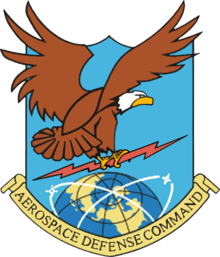318th Fighter-Interceptor Squadron
The 318th Fighter Interceptor Squadron is an inactive United States Air Force unit. Its last assignment was with 25th Air Division based at McChord AFB, Washington. The squadron was inactivated on 7 December 1989.
| 318th Fighter Interceptor Squadron | |
|---|---|
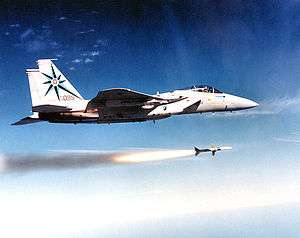 F-15 Eagle of the 318th Fighter Interceptor Squadron | |
| Active | 1942–1945; 1947–1989 |
| Country | |
| Branch | |
| Role | Fighter Interceptor |
| Nickname(s) | Green Dragons |
| Engagements |
|
| Decorations |
|
| Insignia | |
| 318th Fighter Interceptor Squadron emblem (approved 9 November 1955)[1] | 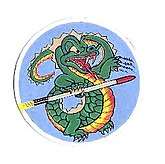 |
| 318th Fighter Squadron emblem (World War II) | 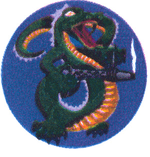 |
History
World War II
It was established in mid-1942 as a fighter squadron, and trained under I Fighter Command primarily in the northeast with Curtiss P-40 Warhawks. It was deployed to the Mediterranean Theater of Operations (MTO) in Algeria, and took part in the North African Campaign supporting the United States Fifth Army's advance with tactical air support. It attacked enemy armored columns, troop concentrations, road transport, bridges and other targets of opportunity. It also flew combat missions over Sicily from airfields in Tunisia, supporting the Allied ground forces in the liberation of the island. The squadron was re-equipped with P-47 Thunderbolts when it moved to Italy in late 1943, and continued tactical operations as part of Twelfth Air Force. It supported the Fifth Army as it advanced into central and northern Italy during the Italian Campaign. the squadron was re-equipped with P-51D Mustangs in 1944. It continued combat operations until the German capitulation, and demobilized in northern Italy during the summer of 1945. It was inactivated in October.
Air Defense Command
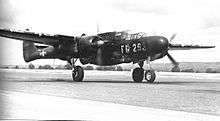
It was reactivated by Air Defense Command in May 1947 at Mitchell Field, New York. In December 1947 it was transferred to Hamilton Field, California where it received its first aircraft, P-61 Black Widows which had been pressed into the air defense mission. In the spring of 1948 the squadron received new F-82 Twin Mustangs and in November 1948 moved to McChord AFB, Washington. In the fall of 1950 the squadron transitioned into jet F-94As Starfire Interceptors.
In June 1953, the squadron moved to Thule Air Base, Greenland, under control of the Northeast Air Command. The squadron came back under ADC in August 1954 when it was moved from Thule to Presque Isle AFB, Maine with F-89D Scorpions. In August 1955 the squadron returned to McChord AFB and transitioned into F-86D Sabres, and became part of the 25th Air Division covering the Northwest Air Defense Sector.
In March 1957, the squadron began a transition into F-102A Delta Daggers and three years later in March 1960 into F-106 Delta Darts. On 22 October 1962, before President John F. Kennedy told Americans that missiles were in place in Cuba, the squadron dispersed one third of its force, equipped with nuclear tipped missiles to Paine Air Force Base at the start of the Cuban Missile Crisis.[2][3] These planes returned to McChord after the crisis.
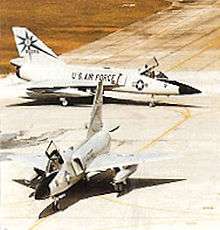
On 15 March 1963, two Soviet bombers overflew Alaska and Alaskan Air Command F-102s were unable to intercept them.[4] The response to this intrusion was to deploy ten F-106s from the squadron and its sister unit, the 498th Fighter-Interceptor Squadron to Alaska in what was called Operation White Shoes.[5] However, maintaining these aircraft for an extended period of time put a strain on the 325th wing's combat readiness back at McChord, and eventually a detachment of maintenance personnel was established to maintain the planes in Alaska. The unit got relief from this commitment while it was upgrading its F-106s from the 1st Fighter-Interceptor Wing, which relieved it from March to June 1964. Operation White Shoes terminated in 1965 and the unit's planes returned home.[6]
On 22 March 1968, the 318th FIS deployed to Osan AB, Republic of Korea from McChord AFB, WA to provide air defense following the 26 January 1968 North Korea seizure of the USS Pueblo. This marked the first time in history that Aerospace Defense Command F-106 fighter interceptors had flown to a critical overseas area, using in-flight refueling along with tactical air units.
It returned to the United States after the Pueblo Crisis ended, and flew F-106s throughout the 1970s. The 318th converted to F-15 Eagles in 1983.
Lineage
- Constituted 318th Fighter Squadron on 24 June 1942
- Activated on 3 August 1942
- Inactivated on 28 October 1945
- Activated on 21 May 1947
- Re-designated: 318th Fighter Squadron (All Weather) on 10 May 1948
- Re-designated: 318th Fighter-All Weather Squadron on 20 January 1950
- Re-designated: 318th Fighter-Interceptor Squadron on 1 May 1951
- Inactivated 7 December 1989.
Assignments
|
|
Stations
|
|
Aircraft
|
|
See also
| Wikimedia Commons has media related to 318th Fighter-All Weather Squadron. |
References
Notes
- Maurer, Combat Squadrons, pp. 388–389
- McMullen, Richard F. (1964) "The Fighter Interceptor Force 1962–1964" ADC Historical Study No. 27, Air Defense Command, Ent Air Force Base, CO (Confidential, declassified 22 March 2000), pp. 10–12
- NORAD/CONAD Participation in the Cuban Missile Crisis, Historical Reference Paper No. 8, Directorate of Command History Continental Air Defense Command, Ent AFB, CO , 1 Feb 63 (Top Secret NOFORN declassified 9 March 1996). P. 16
- McMullen, p. 27
- McMullen, pp. 28–29
- McMullen, pp. 32–34
Bibliography
![]()
- Cornett, Lloyd H.; Johnson, Mildred W. (1980). A Handbook of Aerospace Defense Organization, 1946–1980 (PDF). Peterson AFB, CO: Office of History, Aerospace Defense Center.
- Maurer, Maurer, ed. (1982) [1969]. Combat Squadrons of the Air Force, World War II (PDF) (reprint ed.). Washington, DC: Office of Air Force History. ISBN 0-405-12194-6. LCCN 70605402. OCLC 72556.
- McMullen, Richard F. (1964) "The Fighter Interceptor Force 1962–1964" ADC Historical Study No. 27, Air Defense Command, Ent Air Force Base, CO (Confidential, declassified 22 March 2000)
- Pape, Garry R.; Campbell, John M.; Campbell, Donna (1991). Northrop P-61 Black Widow: The Complete History and Combat Record. Minneapolis, MN: Motorbooks International. ISBN 978-0-879385-09-5.
- NORAD/CONAD Participation in the Cuban Missile Crisis, Historical Reference Paper No. 8, Directorate of Command History Continental Air Defense Command, Ent AFB, CO, 1 Feb 63 (Top Secret NOFORN declassified 9 March 1996)
- "ADCOM's Fighter Interceptor Squadrons". The Interceptor. Aerospace Defense Command. Vol. 21 (No. 1): 5–11, 26–31, 40–45, 54–59. January 1979.
